Single Mode Fiber
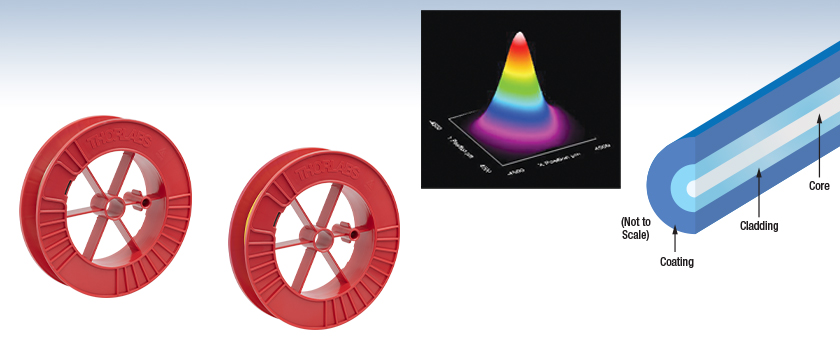
- Operating Wavelengths from 320 nm to 2200 nm
- Shipped from Stock with No Minimum Order
- Patch Cables Available for All Fibers
- Ø80 µm or Ø125 µm Cladding Available
Typical Output Beam Profile from a Single Mode Fiber
Some Fibers are Available with
a Ø900 µm Hytrel Jacket
Single Mode Fiber Cross Section
780HP
780 - 970 nm,
Ø245 µm Acrylate Coating
HI1060-J9
980 - 1650 nm,
Ø900 µm Hytrel® Jacket

Please Wait
| Single Mode Fiber Quick Links |
|---|
| 320 - 430 nm |
| 400 - 680 nm |
| 600 - 860 nm |
| 780 - 970 nm |
| 980 - 1650 nm |
| 1260 - 1650 nm |
| 1850 - 2200 nm |
Features
- Various Single Mode Fibers Available Offering Transmission from 320 to 2200 nm
- Shipped from Stock
- No Minimum Purchase Required
Thorlabs offers these single mode fibers for operating wavelengths from 320 nm to 2200 nm. Details on the physical and optical properties of these fibers are provided in Tables G1.1, G2.1, G3.1, G4.1, G5.1, G6.1, and G7.1. Patch cables that incorporate these fibers are available from stock, see Tables G1.2, G2.2, G3.2, G4.2, G5.2, G6.2, and G7.2 for more information. If our selection of stocked patch cables does not meet your needs, we also offer custom fiber patch cables.

Click to Enlarge
Figure 75A The left image shows the intensity profile of the beam propagated through the fiber overlaid on the fiber itself. The right image shows the standard intensity profile of the beam propagated through the fiber with the MFD and core diameter called out.
Definition of the Mode Field Diameter
The mode field diameter (MFD) is one measure of the beam width of light propagating in a single mode fiber. It is a function of wavelength, core radius, and the refractive indices of the core and cladding. While much of the light in an optical fiber is trapped within the fiber core, a small fraction propagates in the cladding. The light can be approximated as a Gaussian power distribution as shown in Figure 75A, where the MFD is the diameter at which the optical power is reduced to 1/e2 from its peak level.
Measurement of MFD
The measurement of MFD is accomplished by the Variable Aperture Method in the Far Field (VAMFF). An aperture is placed in the far field of the fiber output, and the intensity is measured. As successively smaller apertures are placed in the beam, the intensity levels are measured for each aperture; the data can then be plotted as power vs. the sine of the aperture half-angle (or the numerical aperture for an SM fiber).
The MFD is then determined using Petermann's second definition, which is a mathematical model that does not assume a specific shape of power distribution. The MFD in the near field can be determined from this far-field measurement using the Hankel Transform.
| Quick Links |
|---|
| Damage at the Air / Glass Interface |
| Intrinsic Damage Threshold |
| Preparation and Handling of Optical Fibers |
Laser-Induced Damage in Silica Optical Fibers
The following tutorial details damage mechanisms relevant to unterminated (bare) fiber, terminated optical fiber, and other fiber components from laser light sources. These mechanisms include damage that occurs at the air / glass interface (when free-space coupling or when using connectors) and in the optical fiber itself. A fiber component, such as a bare fiber, patch cable, or fused coupler, may have multiple potential avenues for damage (e.g., connectors, fiber end faces, and the device itself). The maximum power that a fiber can handle will always be limited by the lowest limit of any of these damage mechanisms.
While the damage threshold can be estimated using scaling relations and general rules, absolute damage thresholds in optical fibers are very application dependent and user specific. Users can use this guide to estimate a safe power level that minimizes the risk of damage. Following all appropriate preparation and handling guidelines, users should be able to operate a fiber component up to the specified maximum power level; if no maximum is specified for a component, users should abide by the "practical safe level" described below for safe operation of the component. Factors that can reduce power handling and cause damage to a fiber component include, but are not limited to, misalignment during fiber coupling, contamination of the fiber end face, or imperfections in the fiber itself. For further discussion about an optical fiber’s power handling abilities for a specific application, please contact Thorlabs’ Tech Support.
Damage at the Air / Glass Interface
There are several potential damage mechanisms that can occur at the air / glass interface. Light is incident on this interface when free-space coupling or when two fibers are mated using optical connectors. High-intensity light can damage the end face leading to reduced power handling and permanent damage to the fiber. For fibers terminated with optical connectors where the connectors are fixed to the fiber ends using epoxy, the heat generated by high-intensity light can burn the epoxy and leave residues on the fiber facet directly in the beam path.
| Table 36C Estimated Optical Power Densities on Air / Glass Interfacea | ||
|---|---|---|
| Type | Theoretical Damage Thresholdb | Practical Safe Levelc |
| CW (Average Power) |
~1 MW/cm2 | ~250 kW/cm2 |
| 10 ns Pulsed (Peak Power) |
~5 GW/cm2 | ~1 GW/cm2 |
Damage Mechanisms on the Bare Fiber End Face
Damage mechanisms on a fiber end face can be modeled similarly to bulk optics, and industry-standard damage thresholds for UV Fused Silica substrates can be applied to silica-based fiber. However, unlike bulk optics, the relevant surface areas and beam diameters involved at the air / glass interface of an optical fiber are very small, particularly for coupling into single mode (SM) fiber. therefore, for a given power density, the power incident on the fiber needs to be lower for a smaller beam diameter.
Table 36C lists two thresholds for optical power densities: a theoretical damage threshold and a "practical safe level". In general, the theoretical damage threshold represents the estimated maximum power density that can be incident on the fiber end face without risking damage with very good fiber end face and coupling conditions. The "practical safe level" power density represents minimal risk of fiber damage. Operating a fiber or component beyond the practical safe level is possible, but users must follow the appropriate handling instructions and verify performance at low powers prior to use.
Calculating the Effective Area for Single Mode Fibers
The effective area for single mode (SM) fiber is defined by the mode field diameter (MFD), which is the cross-sectional area through which light propagates in the fiber; this area includes the fiber core and also a portion of the cladding. To achieve good efficiency when coupling into a single mode fiber, the diameter of the input beam must match the MFD of the fiber.
As an example, SM400 single mode fiber has a mode field diameter (MFD) of ~Ø3 µm operating at 400 nm, while the MFD for SMF-28 Ultra single mode fiber operating at 1550 nm is Ø10.5 µm. The effective area for these fibers can be calculated as follows:
SM400 Fiber: Area = Pi x (MFD/2)2 = Pi x (1.5 µm)2 = 7.07 µm2 = 7.07 x 10-8 cm2
SMF-28 Ultra Fiber: Area = Pi x (MFD/2)2 = Pi x (5.25 µm)2 = 86.6 µm2 = 8.66 x 10-7 cm2
To estimate the power level that a fiber facet can handle, the power density is multiplied by the effective area. Please note that this calculation assumes a uniform intensity profile, but most laser beams exhibit a Gaussian-like shape within single mode fiber, resulting in a higher power density at the center of the beam compared to the edges. Therefore, these calculations will slightly overestimate the power corresponding to the damage threshold or the practical safe level. Using the estimated power densities assuming a CW light source, we can determine the corresponding power levels as:
SM400 Fiber: 7.07 x 10-8 cm2 x 1 MW/cm2 = 7.1 x 10-8 MW = 71 mW (Theoretical Damage Threshold)
7.07 x 10-8 cm2 x 250 kW/cm2 = 1.8 x 10-5 kW = 18 mW (Practical Safe Level)
SMF-28 Ultra Fiber: 8.66 x 10-7 cm2 x 1 MW/cm2 = 8.7 x 10-7 MW = 870 mW (Theoretical Damage Threshold)
8.66 x 10-7 cm2 x 250 kW/cm2 = 2.1 x 10-4 kW = 210 mW (Practical Safe Level)
Effective Area of Multimode Fibers
The effective area of a multimode (MM) fiber is defined by the core diameter, which is typically far larger than the MFD of an SM fiber. For optimal coupling, Thorlabs recommends focusing a beam to a spot roughly 70 - 80% of the core diameter. The larger effective area of MM fibers lowers the power density on the fiber end face, allowing higher optical powers (typically on the order of kilowatts) to be coupled into multimode fiber without damage.
Damage Mechanisms Related to Ferrule / Connector Termination
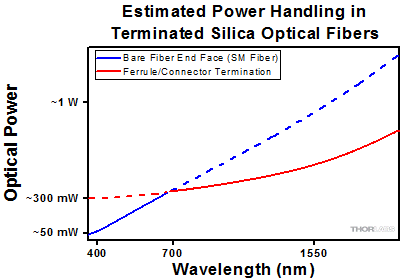 Click to Enlarge
Click to EnlargeFigure 36D Plot showing approximate input power that can be incident on a single mode silica optical fiber with a termination. Each line shows the estimated power level due to a specific damage mechanism. The maximum power handling is limited by the lowest power level from all relevant damage mechanisms (indicated by a solid line).
Fibers terminated with optical connectors have additional power handling considerations. Fiber is typically terminated using epoxy to bond the fiber to a ceramic or steel ferrule. When light is coupled into the fiber through a connector, light that does not enter the core and propagate down the fiber is scattered into the outer layers of the fiber, into the ferrule, and the epoxy used to hold the fiber in the ferrule. If the light is intense enough, it can burn the epoxy, causing it to vaporize and deposit a residue on the face of the connector. This results in localized absorption sites on the fiber end face that reduce coupling efficiency and increase scattering, causing further damage.
For several reasons, epoxy-related damage is dependent on the wavelength. In general, light scatters more strongly at short wavelengths than at longer wavelengths. Misalignment when coupling is also more likely due to the small MFD of short-wavelength SM fiber that also produces more scattered light.
To minimize the risk of burning the epoxy, fiber connectors can be constructed to have an epoxy-free air gap between the optical fiber and ferrule near the fiber end face. Our high-power multimode fiber patch cables use connectors with this design feature.
Determining Power Handling with Multiple Damage Mechanisms
When fiber cables or components have multiple avenues for damage (e.g., fiber patch cables), the maximum power handling is always limited by the lowest damage threshold that is relevant to the fiber component. In general, this represents the highest input power that can be incident on the patch cable end face and not the coupled output power.
As an illustrative example, Figure 36D shows an estimate of the power handling limitations of a single mode fiber patch cable due to damage to the fiber end face and damage via an optical connector. The total input power handling of a terminated fiber at a given wavelength is limited by the lower of the two limitations at any given wavelength (indicated by the solid lines). A single mode fiber operating at around 488 nm is primarily limited by damage to the fiber end face (blue solid line), but fibers operating at 1550 nm are limited by damage to the optical connector (red solid line).
In the case of a multimode fiber, the effective mode area is defined by the core diameter, which is larger than the effective mode area for SM fiber. This results in a lower power density on the fiber end face and allows higher optical powers (on the order of kilowatts) to be coupled into the fiber without damage (not shown in graph). However, the damage limit of the ferrule / connector termination remains unchanged and as a result, the maximum power handling for a multimode fiber is limited by the ferrule and connector termination.
Please note that these are rough estimates of power levels where damage is very unlikely with proper handling and alignment procedures. It is worth noting that optical fibers are frequently used at power levels above those described here. However, these applications typically require expert users and testing at lower powers first to minimize risk of damage. Even still, optical fiber components should be considered a consumable lab supply if used at high power levels.
Intrinsic Damage Threshold
In addition to damage mechanisms at the air / glass interface, optical fibers also display power handling limitations due to damage mechanisms within the optical fiber itself. These limitations will affect all fiber components as they are intrinsic to the fiber itself. Two categories of damage within the fiber are damage from bend losses and damage from photodarkening.
Bend Losses
Bend losses occur when a fiber is bent to a point where light traveling in the core is incident on the core/cladding interface at an angle higher than the critical angle, making total internal reflection impossible. Under these circumstances, light escapes the fiber, often in a localized area. The light escaping the fiber typically has a high power density, which burns the fiber coating as well as any surrounding furcation tubing.
A special category of optical fiber, called double-clad fiber, can reduce the risk of bend-loss damage by allowing the fiber’s cladding (2nd layer) to also function as a waveguide in addition to the core. By making the critical angle of the cladding/coating interface higher than the critical angle of the core/clad interface, light that escapes the core is loosely confined within the cladding. It will then leak out over a distance of centimeters or meters instead of at one localized spot within the fiber, minimizing the risk of damage. Thorlabs manufactures and sells 0.22 NA double-clad multimode fiber, which boasts very high, megawatt range power handling.
Photodarkening
A second damage mechanism, called photodarkening or solarization, can occur in fibers used with ultraviolet or short-wavelength visible light, particularly those with germanium-doped cores. Fibers used at these wavelengths will experience increased attenuation over time. The mechanism that causes photodarkening is largely unknown, but several fiber designs have been developed to mitigate it. For example, fibers with a very low hydroxyl ion (OH) content have been found to resist photodarkening and using other dopants, such as fluorine, can also reduce photodarkening.
Even with the above strategies in place, all fibers eventually experience photodarkening when used with UV or short-wavelength light, and thus, fibers used at these wavelengths should be considered consumables.
Preparation and Handling of Optical Fibers
General Cleaning and Operation Guidelines
These general cleaning and operation guidelines are recommended for all fiber optic products. Users should still follow specific guidelines for an individual product as outlined in the support documentation or manual. Damage threshold calculations only apply when all appropriate cleaning and handling procedures are followed.
-
All light sources should be turned off prior to installing or integrating optical fibers (terminated or bare). This ensures that focused beams of light are not incident on fragile parts of the connector or fiber, which can possibly cause damage.
-
The power-handling capability of an optical fiber is directly linked to the quality of the fiber/connector end face. Always inspect the fiber end prior to connecting the fiber to an optical system. The fiber end face should be clean and clear of dirt and other contaminants that can cause scattering of coupled light. Bare fiber should be cleaved prior to use and users should inspect the fiber end to ensure a good quality cleave is achieved.
-
If an optical fiber is to be spliced into the optical system, users should first verify that the splice is of good quality at a low optical power prior to high-power use. Poor splice quality may increase light scattering at the splice interface, which can be a source of fiber damage.
-
Users should use low power when aligning the system and optimizing coupling; this minimizes exposure of other parts of the fiber (other than the core) to light. Damage from scattered light can occur if a high power beam is focused on the cladding, coating, or connector.
Tips for Using Fiber at Higher Optical Power
Optical fibers and fiber components should generally be operated within safe power level limits, but under ideal conditions (very good optical alignment and very clean optical end faces), the power handling of a fiber component may be increased. Users must verify the performance and stability of a fiber component within their system prior to increasing input or output power and follow all necessary safety and operation instructions. The tips below are useful suggestions when considering increasing optical power in an optical fiber or component.
-
Splicing a fiber component into a system using a fiber splicer can increase power handling as it minimizes possibility of air/fiber interface damage. Users should follow all appropriate guidelines to prepare and make a high-quality fiber splice. Poor splices can lead to scattering or regions of highly localized heat at the splice interface that can damage the fiber.
-
After connecting the fiber or component, the system should be tested and aligned using a light source at low power. The system power can be ramped up slowly to the desired output power while periodically verifying all components are properly aligned and that coupling efficiency is not changing with respect to optical launch power.
-
Bend losses that result from sharply bending a fiber can cause light to leak from the fiber in the stressed area. When operating at high power, the localized heating that can occur when a large amount of light escapes a small localized area (the stressed region) can damage the fiber. Avoid disturbing or accidently bending fibers during operation to minimize bend losses.
-
Users should always choose the appropriate optical fiber for a given application. For example, large-mode-area fibers are a good alternative to standard single mode fibers in high-power applications as they provide good beam quality with a larger MFD, decreasing the power density on the air/fiber interface.
-
Step-index silica single mode fibers are normally not used for ultraviolet light or high-peak-power pulsed applications due to the high spatial power densities associated with these applications.
| Posted Comments: | |
prathmesh Ghag
(posted 2025-10-29 11:26:33.153) Dear Sir/Maam,
I am interested in the Numerical Aperture values of the S405-XP and SM450 at wavelength 633nm. Could they be provided? In the spec tab it is given as a range and it is difficult to compare.
I am interested in purchasing the one with higher NA at 633nm.
Thank you for your time.
Regards,
Prathmesh Ghag EGies
(posted 2025-10-30 12:22:59.0) Thank you for contacting Thorlabs. The NA is given as a range due to tolerancing of the fiber's design values, not due strictly to wavelength. I have reached out to you directly to discuss your particular application. Benjamin GREVIN
(posted 2025-09-12 08:07:49.353) Dear support team
Could you kindly confirm what is the coating material ? It is mentionned that the SM fibers are protected by an outer acrylate jacket, but nothing is a priori said about the primary coating material (if I am wrong, please forgive me).
This is of high importance - in my case - for I plan to use the fibers for in vacuum application.
Thanking you by advance for your feedback
With kind regards
Benjamin
B. GREVIN, PhD, CNRS Research director
Institut Néel Grenoble, France tdevkota
(posted 2025-09-15 01:11:38.0) Thank you for contacting Thorlabs. The typical fiber coating consists of two layers of standard acrylate materials. Depending on the application and environmental conditions, other coatings such as high-temperature acrylate, polyimide, metal, or carbon may also be applied in single- or dual-layer structures. I have reached out to you directly to discuss the specific SM fiber you’re interested in. Chris Betters
(posted 2025-03-27 05:43:20.25) Hi team,
The per meter weight estimate seems high? Is this correct? It results in a large weight and thus shipping estimates at checkout.
Cheers
Chris EGies
(posted 2025-03-28 12:48:45.0) Thank you for contacting Thorlabs. Yes, the per meter weight for SM600 is correct. I have reached out to you directly regarding your specific application. user
(posted 2025-01-28 20:41:08.97) Could you kindly advise whether the 780HP or the 630HP would be more suitable for the wavelength of 852 nm?
We want to proceed with adding the fiber as soon as possible.
Looking forward to your advice.
Best regards,
Poonam Yadav cdolbashian
(posted 2025-01-30 01:11:26.0) Thank you for reaching out to us with this inquiry. As the 780HP fiber is designed for the wavelength range of 780-970nm, the 780HP would be most suited for 852nm. peter lee
(posted 2022-11-23 14:15:35.047) what is dispersion at wavelength 1030 nm?
Is there dispersion curve(v.s wavelength) of this fiber?
any information of dispersion is helpful!thanks! jgreschler
(posted 2022-11-23 11:35:20.0) Thank you for reaching out to Thorlabs. Additional data and specs can be requested by reaching out to techsupport@thorlabs.com. For 1550BHP this fiber unfortunately we do not have data at 1030 since it is outside the operating range. Ewa Mączyńska
(posted 2022-09-23 12:16:40.4) Hi,
can you delivery information about disperion for SMF-28-J9 (espacially for 1310 nm, I have laser 1310 nm central wavelenght, 50 nm bandwidth).
Kind Regards,
Ewa Mączyńska 李 彥澄
(posted 2022-04-06 18:21:12.733) what is the dispersion vs.wavelength diagram of SM450? jgreschler
(posted 2022-04-06 10:21:58.0) Thank you for reaching out to Thorlabs. Additional data, including dispersion for any of our single mode fibers, can be requested by contacting techsupport@thorlabs.com. I have reached out to you directly with the requested data. Dennis Suh
(posted 2020-02-21 03:23:51.597) Hi, I am Dennis.
Actually, I need DCF instead of YOFC's to make DCM for SKT 5G project in Korean front haul network.
So, I visit your site and I can know you discontinue your DCF38.
But I want to know if you have some stock, I want to buy it.
Thanks. llamb
(posted 2020-02-25 01:55:38.0) Hello Dennis, thank you for your feedback. Unfortunately we no longer stock DCF38. I apologize for any inconvenience this may cause. user
(posted 2019-07-01 16:07:34.273) Hello, I would like to ask about Thorlabs fiber DCF38, a dispersion-compensating fiber, whether it can be used to compensate for dispersion in the 2um band (1.8um -- 2um)? At the time, our fiber was purchased from your company. If you can answer my doubts, I would be grateful, thank you. YLohia
(posted 2019-07-01 10:52:41.0) Hello, thank you for contacting Thorlabs. We do not recommend using this fiber for the 2um band due to its high attenuation at that range. This fiber is designed for use between 1520-1625nm. user
(posted 2019-06-19 13:20:35.84) Dear Sir or Madam,
I need a plot of transmission as a function of wavelength for the P1-460B-FC-2 (SM450).
I look forward to hearing from you.
Best regards YLohia
(posted 2019-06-19 04:16:47.0) Hello, thank you for your interest in our products. I have reached out to you directly with the attenuation plot for this fiber. mlarsson
(posted 2008-08-26 08:59:22.0) Why is this fiber only specified up to 1060 nm
when Nufern 1060XP is specified up to 1600 nm |

Thorlabs' SM300 fiber consists of an undoped, pure silica core surrounded by a depressed, fluorine-doped cladding and dual acrylate coating. Since this fiber does not contain germania (GeO2), which causes electronic defects and color centers associated with the Ge-O bond, the primary cause of photodarkening is greatly reduced. As a result, power handling in the blue region is increased from several milliwatts to several watts. The transmission-limiting effects caused by other nonlinearities (e.g., stimulated scattering) or even thermal damage are also reduced compared to those of a conventional silica fiber doped with germanium. In the UV region, the SM300 fiber will still exhibit some photodarkening, but will have superior performance compared to conventional fibers.
| Table G1.1 Fiber Specifications | |||||
|---|---|---|---|---|---|
| Item # | Operating Wavelength | Mode Field Diametera | Cladding Diameter | Coating Diameter | Cut-Off Wavelength |
| SM300 | 320 - 430 nm | 2.0 - 2.4 µm @ 350 nm | 125 ± 1 µm | 245 ± 15 µm | ≤310 nm |
| Item # | Short-Term Bend Radius | Long-Term Bend Radius | Attenuation (Max) | Proof Test Level | NA | Core Indexb | Cladding Indexb |
|---|---|---|---|---|---|---|---|
| SM300 | ≥10 mm | ≥30 mm | ≤100 dB/km @ 350 nm ≤130 dB/km @ 430 nm |
1% (100 kpsi) | 0.12 - 0.14 | 320 nm: 1.48274 375 nm: 1.47314 430 nm: 1.46719 |
320 nm: 1.47703 375 nm: 1.46739 430 nm: 1.46142 |
| Table G1.2 Stock Patch Cables Available with This Fiber | ||
|---|---|---|
| SM300 Fiber |
Custom cables are also available. Click here for details.

These fibers enable single mode transmission from 400 - 680 nm and feature an acrylate jacket. The S405-XP and SM400 fibers both consist of an undoped, pure silica core, and the SM400 fiber is surrounded by a depressed, fluorine-doped cladding. Since these two fibers do not contain germania (GeO2), which causes electronic defects and color centers associated with the Ge-O bond, the primary cause of photodarkening is greatly reduced. The transmission-limiting effects caused by other nonlinearities (e.g., stimulated scattering) or even thermal damage are also reduced compared to those of a conventional silica fiber doped with germanium.
| Table G2.1 Fiber Specifications | |||||
|---|---|---|---|---|---|
| Item # | Operating Wavelength | Mode Field Diameterb | Cladding Diameter | Coating Diameter | Cut-Off Wavelength |
| S405-XP | 400 - 680 nm | 3.3 ± 0.5 µm @ 405 nm 4.6 ± 0.5 µm @ 630 nm |
125.0 ± 1.0 µm | 245.0 ± 15.0 µm | 380 ± 20 nm |
| SM400 | 405 - 532 nm | 2.5 - 3.4 µm @ 480 nm | 125 ± 1 µm | 245 ± 15 µm | 305 - 400 nm |
| SM450a | 488 - 633 nm | 2.8 - 4.1 µm @ 488 nm | 125 ± 1.0 µm | 245 ± 15 µm | 350 - 470 nm |
| 460HP | 450 - 600 nm | 3.5 ± 0.5 µm @ 515 nm | 125 ± 1 µm | 245 ± 15 µm | 430 ± 20 nm |
| Item # | Short-Term Bend Radius | Long-Term Bend Radius | Attenuation (Max) | Proof Test Level | NA | Core Index | Cladding Index |
|---|---|---|---|---|---|---|---|
| S405-XP | ≥6 mm | ≥13 mm | ≤30.0 dB/km @ 630 nm ≤30.0 dB/km @ 488 nm |
≥200 kpsi (1.4 GN/m2) | 0.12 | Calld | Calld |
| SM400 | ≥10 mm | ≥30 mm | ≤50 dB/km @ 430 nm ≤30 dB/km @ 532 nm |
1% (100 kpsi) | 0.12 - 0.14 | 405 nm: 1.46958e 467 nm: 1.46435e 532 nm: 1.46071e |
405 nm: 1.46382e 467 nm: 1.45857e 532 nm: 1.45491e |
| SM450 | ≥5 mm | ≥25 mm | ≤50 dB/km @ 488 nmc | 1% (100 kpsi) | 0.10 - 0.14 | 488 nm: 1.46645f 514 nm: 1.46501f |
488 nm: 1.46302f 514 nm: 1.46159f |
| 460HP | ≥6 mm | ≥13 mm | ≤30 dB/km @ 515 nm | ≥200 kpsi (1.4 GN/m2) | 0.13 | Calld | Calld |
| Table G2.2 Stock Patch Cables Available with These Fibers | ||
|---|---|---|
| S405-XP Fiber |
| SM400 Fiber |
| SM450 Fiber |
Custom cables are also available. Click here for details.

These fibers feature an acrylate coating and enable single mode transmission from 600 - 860 nm. This transmission range enables true single mode operation at the HeNe lasing line (632.8 nm) and for many visible wavelength laser diodes. These fibers have exceptional core/cladding concentricity which reduces insertion and bend losses. The 630HP fiber offers tight second mode cut-off tolerances, ensuring single mode operation over the full transmission range.
| Table G3.1 Fiber Specifications | |||||
|---|---|---|---|---|---|
| Item # | Operating Wavelength | Mode Field Diameterb | Cladding Diameter | Coating Diameter | Cut-Off Wavelengthc |
| SM600 | 633 - 780 nma | 3.6 - 5.3 µm @ 633 nm | 125 ± 1 µm | 245 ± 15 µm | 500 - 600 nm |
| S630-HP | 630 - 860 nm | 4.2 ± 0.5 µm @ 630 nm | 125 ± 1.0 µm | 245 ± 15 µm | 590 ± 30 nm |
| 630HP | 600 - 770 nm | 4.0 ± 0.5 µm @ 630 nm | 125 ± 1 µm | 245 ± 15 µm | 570 ± 30 nm |
| Item # | Short-Term Bend Radius | Long-Term Bend Radius | Max Attenuation | Proof Test Level | NA | Core Index | Cladding Index |
|---|---|---|---|---|---|---|---|
| SM600 | ≥5 mm | ≥25 mm | ≤15 dB/kmd | 1% (100 kpsi) | 0.10 - 0.14 | 600 nm: 1.46147e 700 nm: 1.45872e 800 nm: 1.45675e |
600 nm: 1.45804e 700 nm: 1.45530e 800 nm: 1.45332e |
| S630-HP | ≥6 mm | ≥13 mm | ≤10 dB/km @ 630 nm | 2% (200 kpsi) | 0.12 | Callf | Callf |
| 630HP | ≥6 mm | ≥13 mm | ≤12 dB/km @ 630 nm | ≥2% (200 kpsi) | 0.13 | Callf | Callf |
| Table G3.2 Stock Patch Cables Available with These Fibers | ||
|---|---|---|
| SM600 Fiber |
| S630-HP Fiber |
Custom cables are also available. Click here for details.

These fibers enable single mode transmission from 780 - 970 nm and feature an acrylate jacket. These fibers have exceptional core/cladding concentricity which reduces insertion and bend losses. The 780HP fiber offers tight second mode cut-off tolerances, ensuring single mode operation over the full transmission range. The SM800G80 has enhanced bend insensitivity, which reduces losses.
| Table G4.1 Fiber Specifications | |||||
|---|---|---|---|---|---|
| Item # | Operating Wavelength | Mode Field Diameterb | Cladding Diameter | Coating Diameter | Cut-Off Wavelength |
| 780HP | 780 - 970 nm | 5.0 ± 0.5 µm @ 850 nm | 125 ± 1 µm | 245 ± 15 µm | 730 ± 30 nm |
| SM800-5.6-125 | 830 - 980 nma | 4.7 - 6.9 µm @ 830 nm | 125 ± 1.0 µm | 245 ± 15 µm | 660 - 800 nm |
| SM800G80 | 830 - 980 nma | 3.75 - 4.9 µm @ 830 nm | 80 ± 1 µm | 170 ± 10 µm | 660 - 800 nm |
| Item # | Short-Term Bend Radius | Long-Term Bend Radius | Attenuation (Max) | Proof Test Level | NA | Core Index | Cladding Index |
|---|---|---|---|---|---|---|---|
| 780HP | ≥6 mm | ≥13 mm | ≤4.0 dB/km @ 780 nm ≤3.5 dB/km @ 850 nm |
2% (200 kpsi) | 0.13 | Calld | Calld |
| SM800-5.6-125 | ≥5 mm | ≥25 mm | <5 dB/kmc | 1% (100 kpsi) | 0.10 - 0.14 | 830 nm: 1.45625e | 830 nm: 1.45282e |
| SM800G80 | ≥5 mm | ≥12 mm (or 38 mm for 25 Year Life) |
≤3.0 dB/kmc | 1% (100 kpsi) | 0.14 - 0.18 | 830 nm: 1.45954f | 830 nm: 1.45282f |
| Table G4.2 Stock Patch Cables Available with These Fibers | ||
|---|---|---|
| 780HP Fiber |
| SM800-5.6-125 Fiber |
Custom cables are also available. Click here for details.

These fibers are designed for operation in the 980 - 1650 nm wavelength range. The SM980-5.8-125 fiber has a mode field diameter (MFD) matched to other fibers used in Erbium-Doped Fiber Amplifier (EDFA) pump laser pigtails. See the MFD Definition tab for a description of MFD. The HI1060-J9 fiber has a Ø900 µm tight-buffer Hytrel outer jacket. We also offer stocked 100 m lengths of the HI1060-J9 fiber (Item # HI1060-100). Our SM980G80 fiber offers enhanced bend insensitivity, which reduces losses, and the 980HP and 1060XP fibers offer a tight second mode cut-off tolerance, ensuring single mode operation over the full transmission range.
| Table G5.1 Fiber Specifications | |||||
|---|---|---|---|---|---|
| Item # | Operating Wavelength | Mode Field Diametera | Cladding Diameter | Coating Diameter | Cut-Off Wavelength |
| SM980-5.8-125 | 980 - 1550 nm | 5.3 - 6.4 µm @ 980 nm | 125 ± 1 µm | 245 ± 15 µm | 870 - 970 nm |
| SM980G80 | 980 - 1550 nm | 4.2 - 4.9 µm @ 980 nm | 80 ± 1 µm | 170 ± 10 µm | 870 - 970 nm |
| 1060XP | 980 - 1600 nm | 5.9 ± 0.5 µm @ 980 nm 6.2 ± 0.5 µm @ 1060 nm 9.5 ± 0.5 µm @ 1550 nm |
125 ± 0.5 µm | 245 ± 10 µm | 920 ± 30 nm |
| 980HP | 980 - 1600 nm | 4.2 ± 0.5 µm @ 980 nm 6.8 ± 0.5 µm @ 1550 nm |
125 ± 1 µm | 245 ± 15 µm | 920 ± 30 nm |
| HI1060-J9 | 980 - 1650 nm | 5.9 ± 0.3 µm @ 980 nm 6.2 ± 0.3 µm @ 1060 nm |
125 ± 0.5 µm | 245 ± 10 µm | 920 ± 50 nm |
| Item # | Short-Term Bend Radius | Long-Term Bend Radius | Attenuation (Max) | Proof Test Level | NA | Core Index | Cladding Index |
|---|---|---|---|---|---|---|---|
| SM980-5.8-125 | ≥5 mm | ≥25 mm | ≤2.0 dB/kmb | 1% (100 kpsi) | 0.13 - 0.15 | 970 nm: 1.45660c 1310 nm: 1.45259c 1650 nm: 1.44854c |
970 nm: 1.45081c 1310 nm: 1.44680c 1650 nm: 1.44275c |
| SM980G80 | ≥5 mm | ≥12 mm (or 38 mm for 25 Year Life) | ≤2 dB/km | 1% (100 kpsi) | 0.17 - 0.19 | 980 nm: 1.46058d 1310 nm: 1.45670d 1650 nm: 1.45265d |
980 nm: 1.45068d 1310 nm: 1.44680d 1650 nm: 1.44275d |
| 1060XP | ≥6 mm | ≥13 mm | ≤2.1 dB/km @ 980 nm ≤1.5 dB/km @ 1060 nm |
200 kpsi (1.4 GN/m2) | 0.14 | Calle | Calle |
| 980HP | ≥6 mm | ≥13 mm | ≤3.5 dB/km @ 980 nm | 200 kpsi (1.4 GN/m2) | 0.20 | Calle | Calle |
| HI1060-J9 | - | - | 2.1 dB/km @ 980 nm 1.5 dB/km @1060 nm |
200 kpsi | 0.14 | Proprietaryf | Proprietaryf |
| Table G5.2 Stock Patch Cables Available with These Fibers | ||
|---|---|---|
| SM980-5.8-125 Fiber |
| HI1060-J9 Fiber |

This group of fibers enables single mode transmission from 1260 - 1650 nm. The 1310BHP, SM1250G80, 1550BHP, and SM1500G80 fibers have dual-acrylate coatings, while the SM1550P fiber has a polyimide coating for high-temperature performance in the telecom region. For more details on the SM1550P fiber, see the full web presentation here. The SMF-28-J9 fiber has a Ø900 µm tight-buffer Hytrel outer jacket, and is also offered in stocked lengths of 100 m and 1000 m (Item #s SMF-28-100 and SMF-28-1000, respectively). CCC1310-J9 fiber has a Ø900 µm tight-buffer PVC outer jacket and offers enhanced bend insensitivity, which reduces losses. Our SM1250G80 and SM1500G80 fibers also provide enhanced bend insensitivity. The 1550BHP fiber features tight second mode cut-off tolerances, ensuring single mode operation over the full transmission range. DCF4 fiber features a low negative dispersion, allowing it to be used as an effective solution to dispersion problems over short or medium lengths of fiber; see the full web presentation here for details.
| Table G6.1 Fiber Specifications | |||||
|---|---|---|---|---|---|
| Item # | Operating Wavelength | Mode Field Diametera | Cladding Diameter | Coating Diameter | Cut-Off Wavelength |
| SMF-28-J9 | 1260 - 1625 nm | 9.2 ± 0.4 µm @ 1310 nm 10.4 ± 0.5 µm @ 1550 nm |
125 ± 0.7 µm | 242 ± 5 µm | <1260 nm |
| CCC1310-J9 | 1260 - 1625 nm | 8.6 ± 0.4 µm @ 1310 nm 9.7 ± 0.5 µm @ 1550 nm |
125 ± 0.7 µm | 242 ± 5 µm | ≤1260 nm |
| 1310BHP | 1300 - 1625 nm | 8.6 ± 0.5 µm @ 1310 nm 9.7 ± 0.5 µm @ 1550 nm |
125 ± 1.0 µm | 245 ± 15 µm | 1260 ± 30 nm |
| SM1550P | 1310 - 1550 nm | 9.4 µm @ 1310 nm | 125 +1 / -3 µm | 145 ± 5 µm | <1260 nm |
| SM1250G80 | 1310 - 1550 nm | 8.2 - 9.9 µm @ 1310 nm | 80 ± 1 µm | 170 ± 10 µm | 1150 - 1250 nm |
| 1550BHP | 1460 - 1620 nm | 9.5 ± 0.5 µm @ 1550 nm | 125 ± 1.0 µm | 245 ± 15 µm | 1400 ± 50 nm |
| SM1500G80 | 1520 - 1650 nm | 6.0 - 6.8 µm @ 1550 nm | 80 ± 1 µm | 170 ± 10 µm | 1350 - 1520 nm |
| DCF4 | 1530 - 1565 nm | 8.85 - 9.60 µm @ 1550 nm | 125 ± 1.0 µm | 250 ± 5 µm | ≤1500 nm |
| Item # | Short-Term Bend Radius |
Long-Term Bend Radius |
Attenuation (Max) | Proof Test Level | NA (Nominal) |
Core Index | Cladding Index |
|---|---|---|---|---|---|---|---|
| SMF-28-J9 | - | - | ≤0.32 dB/km @ 1310 nm ≤0.18 dB/km @ 1550 nm |
≥100 kpsi (0.7 GN/m2) |
0.14b | Proprietaryc | Proprietaryc |
| CCC1310-J9 | - | - | ≤0.35 dB/km @ 1310 nm ≤0.20 dB/km @ 1550 nm |
≥100 kpsi (0.7 GN/m2) |
0.14 | 1310 nm: 1.4670 1550 nm: 1.4677 |
- |
| 1310BHP | ≥6 mm | ≥13 mm | ≤0.5 dB/km @ 1310 nm & 1550 nm | ≥200 kpsi (1.4 GN/m2) |
0.13 | Calld | Calld |
| SM1550P | ≥13 mm | ≥25 mm | ≤0.7 dB/kme | 50 kpsi | 0.12 | Proprietaryc | Proprietaryc |
| SM1250G80 | ≥5 mm | ≥12 mm (or 38 mm for 25 Year Life) | ≤2 dB/km | 1% (100 kpsi) | 0.11 - 0.13 | 1310 nm: 1.45094f 1550 nm: 1.44813f |
1310 nm: 1.44680f 1550 nm: 1.44399f |
| 1550BHP | ≥6 mm | ≥13 mm | ≤0.5 dB/km @ 1550 nm | ≥200 kpsi (1.4 GN/m2) |
0.13 | Calld | Calld |
| SM1500G80 | ≥5 mm | ≥12 mm (or 38 mm for 25 Year Life) | ≤0.5 dB/km | 1% (100 kpsi) | 0.19 - 0.21 | 1550 nm: 1.45636g | 1550 nm: 1.44399g |
| DCF4 | - | - | ≤0.210 dB/km @ 1550 nm | - | - | Proprietaryc | Proprietaryc |
| Table G6.2 Stock Patch Cables Available with These Fibers | ||
|---|---|---|
| SMF-28 Ultra Fiber |
| 1550BHP Fiber |
Custom cables are also available. Click here for details.

Thorlabs' SM1950 fiber enables single mode transmission from 1850 - 2200 nm. This fiber features a Ge-doped silica core surrounded by a pure silica cladding and a UV-cured acrylate coating. This fiber has exceptional core/cladding concentricity which reduces insertion and bend losses.
| Table G7.1 Fiber Specifications | ||||||
|---|---|---|---|---|---|---|
| Item # | Operating Wavelength | MFDa | Core Diameter | Cladding Diameter | Coating Diameter | Cut-Off Wavelength |
| SM1950 | 1850 - 2200 nm | 8.0 µm @ 1950 nm | 7 µm | 125 ± 1 µm | 245 ± 10 µm | 1720 ± 80 nm |
| Item # | Coating Concentricity | Core-Clad Concentricity | Typical Attenuation | NA | Core Index | Cladding Index |
|---|---|---|---|---|---|---|
| SM1950 | <5 µm | <0.5 µm | 5 dB/km (0.005 dB/m) @ 1.9 µm | 0.20 | Callb | Callb |
| Table G7.2 Stock Patch Cables Available with This Fiber | ||
|---|---|---|
| SM1950 Fiber |
Custom cables are also available. Click here for details.
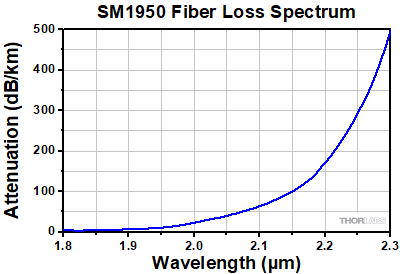
Click to Enlarge
Click for Raw Data
Figure G7.3 This plot contains the measured attenuation for SM1950 fiber across the single mode wavelength range (1850 nm - 2200 nm).
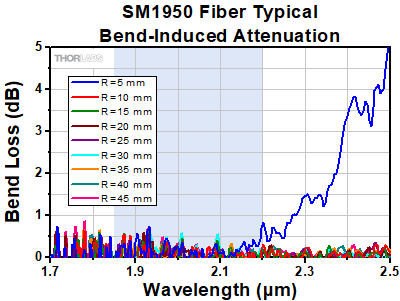
Click to Enlarge
Click for Raw Data
Figure G7.4 This plot contains the measured attenuation for a single loop of SM1950 fiber at nine different bend radii. The shaded region in the plot denotes the single mode wavelength range (1.85 - 2.2 µm).
 Products Home
Products Home











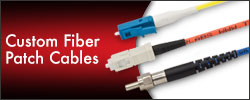
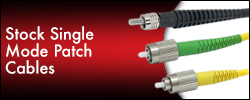
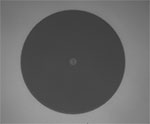
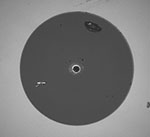
 Single Mode Fiber
Single Mode Fiber